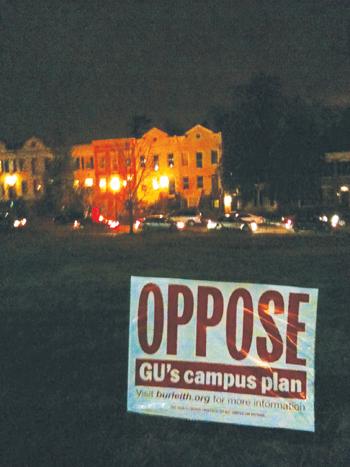The heavily disputed Georgetown University Campus Plan came to something of a climax on Thursday, January 20, when a joint meeting was held between the Georgetown, Burleith, and Foxhall Citizens Associations, the ANC 2E Commission, and GU officials. The assembly, which drew a large number of community residents and even a good handful of University students, was held in the auditorium of Duke Ellington School of the Arts.
James O’Donnell, Executive Provost of GU, along with Dean of Students Todd Olson and University Vice President Spiro Dimolitsas represented the University.
According to ANC Commissioner Ed Solomon, the intent of the meeting was to field information from the at-large community to help reach a resolution in the near future.
“We are proud of and cherish the community of which we are a part,” said O’Donnell, expressing the University’s hope to find a business plan that strikes a balance between it’s needs and the community’s.
He called the campus plan modest (to the sound of bitter chuckles in the audience), with no new large buildings and a modest target growth in graduate school enrollment.
“We are focused on sustainable design and transportation solutions,” continued Olson, who cited significant concerns with potential sites for student campus additions—notably for student housing, the major issue in this debate.
Lenore Rubino, President of the Burleith Citizen’s Association, on behalf of the joint Citizen’s Associations, said that the 2010-2020 campus plan does not address the “egregious problems of the expansion of students.” She cited GU’s campus plan from 2000, wherein the University planned to increase enrollment to 3,800 graduate students by 2010; their current count is 6,275, or a 62% increase in student body population, with almost no new on-campus housing.
“Georgetown University Students disturb and disrupt the community on a regular basis,” Rubino said. She feared openly that the Burleith neighborhood was depreciating irreparably, largely due to nearly 50% of the homes converting to group housing for student rentals.
Between the city blocks of “only rental houses” and concerns with students’ regular public drunkenness and general debauchery, people are considering moving out of the neighborhood. However, even those who try to leave are having trouble selling their homes because of the declining quality of the neighborhood, with dilapidated student houses neglected by the property owners and abused by the student residents.
The joint Citizen’s Association again proposed that the University reinstate its goal from 1990 to house 100% of its undergraduates on campus and agree to reasonable caps on enrollment for graduate and undergraduate students.
For what the meeting commendably intended to do, it became muddled; it attempted to answer the questions of every community member and student that came to the microphone, many of who just wanted a platform to express their inherent disapproval of the other and the campus plan’s effect on their respective communities. Good points were made by many, and laundry lists of complaints and criticisms and questions were raised.
As is the case with many public meetings in this fashion, it became hasty toward the end while the organizers tried to make sure everyone was heard, and it then seemed more gratuitous than constructive. Still, at least for the night, Georgetown residents and some of the more frustrated students were allowed to release their anxieties in a legitimate, recognized venue. Hopefully the University and the joint Citizen’s Associations were able to walk away with useful information for the ensuing negotiations.


